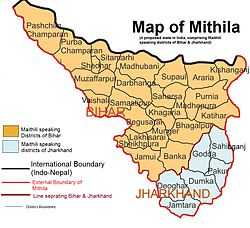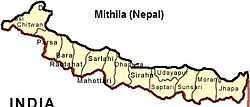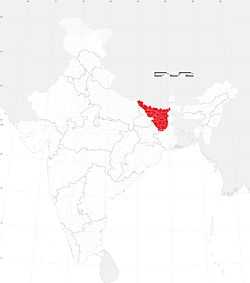Maithil
| Maithil मैथिल/ মৈথিল | |
|---|---|
| Linguistic and historical region | |
|
Maithil-speaking region of India | |
 Mithila region of Nepal | |
 |
| Total population | |
|---|---|
| About 8 crore (2011) | |
| Regions with significant populations | |
| 7.2 crore[1] | |
| 50 million[2] | |
| Primarily Muslim migrants | |
| Languages | |
| Maithili and dialects Angika and Vajjika | |
| Religion | |
| Hinduism, Islam, Sikhism, Christianity, Buddhism and Jainism | |
A Maithil (Devnagri: मैथिल, Tirhuta: মৈথিল) is a native speaker of the Maithili language, and includes all natives of Mithila region of India and Nepal.
They are the ethnic group originating from Janakpur of Mithila region of Nepal.[3]
Region
Maithils are natives of districts south of the Ganges near Bhagalpur and Monghyr, most of North Bihar and the adojining Madhesh of Nepal. All castes living in Mithila and speaking Maithili are Maithils. Most of North Bihar (except for several western districts) centered near Darbhangā-Madhubani, some areas south of the Ganges (including Bhāgalpur and Munger) and the region from Rauthatta to Biratnagar in Nepal (centered near Janakpur, in southeastern Nepal) form modern Mithila. This area was known as the kingdom of Videha, with its capital at Janakpur (or Mithila Nagari). The site has not been identified by archaeologists; however, folklore ascribes it to Janakpurdham in Nepal. The kingdom appears in the Ramayana; according to it and other ancient texts, it is the birthplace of Sita.
Language
The region's common language is Maithili, which is listed in the Eighth Schedule of the Indian Constitution. It is an ancient language, from which Bengali and related scripts have evolved. The oldest example of this Mithilakshar or Tirhuta script is a Shiva temple inscription in Tilkeshwarsthāna (near Kusheshwarsthāna, in Darbhangā district), in which it is mentioned in Eastern Māgadhi Prākrit that the temple was built on "Kāttika sudi" (Kārtika Shukla pratipadā, or the first tithi in the bright half of the Hindu lunar month of Kārtika) in "Shake 125" (AD 203) on the day after Diwāli (still regarded as auspicious for installing an icon in a temple). The script of the inscription is little different from modern Maithili script. However, during the 20th century most Maithili writers gradually adopted Devanagari script for Maithili.[4] Some traditional pandits still use Tirhutā or Mithilākshara script for pātā (ceremonial letters related to important functions, such as marriage). Fonts for this script were developed in 2003. Maithils are descended from an ancient society which has created works of Maithili literature.
Cross-border regionalism
Mithila regionalism unites Maithils of India and Maithali of Nepal from both sides of international border. Since they share a common history, language, culture, ethnicity, and same origin from Janakpur they feel part of one Mithila. Positive events on one side of the international border are celebrated on the other side, and negative events are mourned on both sides.[5]
Indian discrimination
Maithils in Indian side are officially known as Bihari. Discrimination against the Maithil community in India is not based on race, caste or color but on geography. The economic gap between the Mithila region and the other area of Bihar south of the Ganges is apparent.[6] The Mithila region is relatively undeveloped, and the government has no concrete plan to address the region's flood problems.[6] It is considered one of India's poorest regions, with a high rate of migration.
Janakpur bombing
On 26 April 2012, the Unified Communist Party of Nepal (Maoist) submitted a proposal for 11 federal units in Nepal in which Mithila was not mentioned. The proposal was opposed by local residents,[7] who submitted a memorandum to Mithila district headquarters requesting a Mithila federal unit in Nepal. A signature campaign was launched throughout the region in which local residents actively participated.[8] On 30 April, local Maithali were conducting a peaceful protest on Ramananda Chowk in Janakpur. About 10 am, the protest was bombed; five people were killed, three more died later and more than forty were injured.[9] Maithali actress Anju Jha was one of those killed in the bombing; she had become popular in Mukhiyaa Jyu several months earlier.
Later that day a little-known armed political group, Janatantrik Terai Mukti Morcha (Democratic Terai Liberation Front), claimed responsibility to local media in a text message. Rajan Mukti was the primary suspect.[10] The blast in Janakpur and its victims angered local residents, who protested peacefully.
See also
- Mithila (Nepal)
- Tirhut
References
- ↑ Dr. Arun C. Mehta. "District-wise Population (Census) Data: 2001 Census, India". Educationforallinindia.com. Retrieved 2013-07-18.
- ↑ "CENSUS 2011 : Nepal's population is 26,620,809". Allvoices.com. Retrieved 2013-09-22.
- ↑ "origin of Maithil people".
- ↑ Chaudhary, Pranava (May 22, 2011). "US scholar's project of encoding Tirhuta script into digital media". The Times of India. Bennett, Coleman & Co. Ltd. Retrieved 26 July 2013.
- ↑ "Maithil of India mourned for Maithali of Nepal who losts lives in Janakpur bombing 9205721". Jagran.com. 2012-05-02. Retrieved 2013-09-22.
- ↑ 6.0 6.1 "बिहार में तेज़ी से पनप रहा है तेलंगाना | जनतंत्र". Janatantra.com. Retrieved 2013-09-22.
- ↑ "BBC Nepali - समाचार - माओवादी संघीय प्रस्तावप्रति आपत्ति". Bbc.co.uk. 1970-01-01. Retrieved 2013-09-22.
- ↑ Himalayan News Service (28 April 2012). "Locals oppose Mithila division". The Himalayan Times. Retrieved 3 August 2013.
- ↑ "4 killed in nepal bomb blast 9199126". Jagran.com. 2013-09-17. Retrieved 2013-09-22.
- ↑ Manesh Shrestha (April 30, 2012). "5 Nepali Maithili died in Nepal blast, little know group claims responsibility". The Times of India. Retrieved August 3, 2013.
